Activity Based Costing: Benefits and Implementation for Iron Mountain Incorporation
VerifiedAdded on 2023/06/11
|15
|3199
|156
AI Summary
This paper discusses the benefits and implementation of Activity Based Costing for Iron Mountain Incorporation. It explains how the ABC model aligns with the organization's goals and strategies, and provides recommendations for its adoption and implementation.
Contribute Materials
Your contribution can guide someone’s learning journey. Share your
documents today.

Activity Based Costing 1
ACTIVITY BASED COSTING
By (Student’s Name)
Professor’s Name
College
Course
Date
ACTIVITY BASED COSTING
By (Student’s Name)
Professor’s Name
College
Course
Date
Secure Best Marks with AI Grader
Need help grading? Try our AI Grader for instant feedback on your assignments.
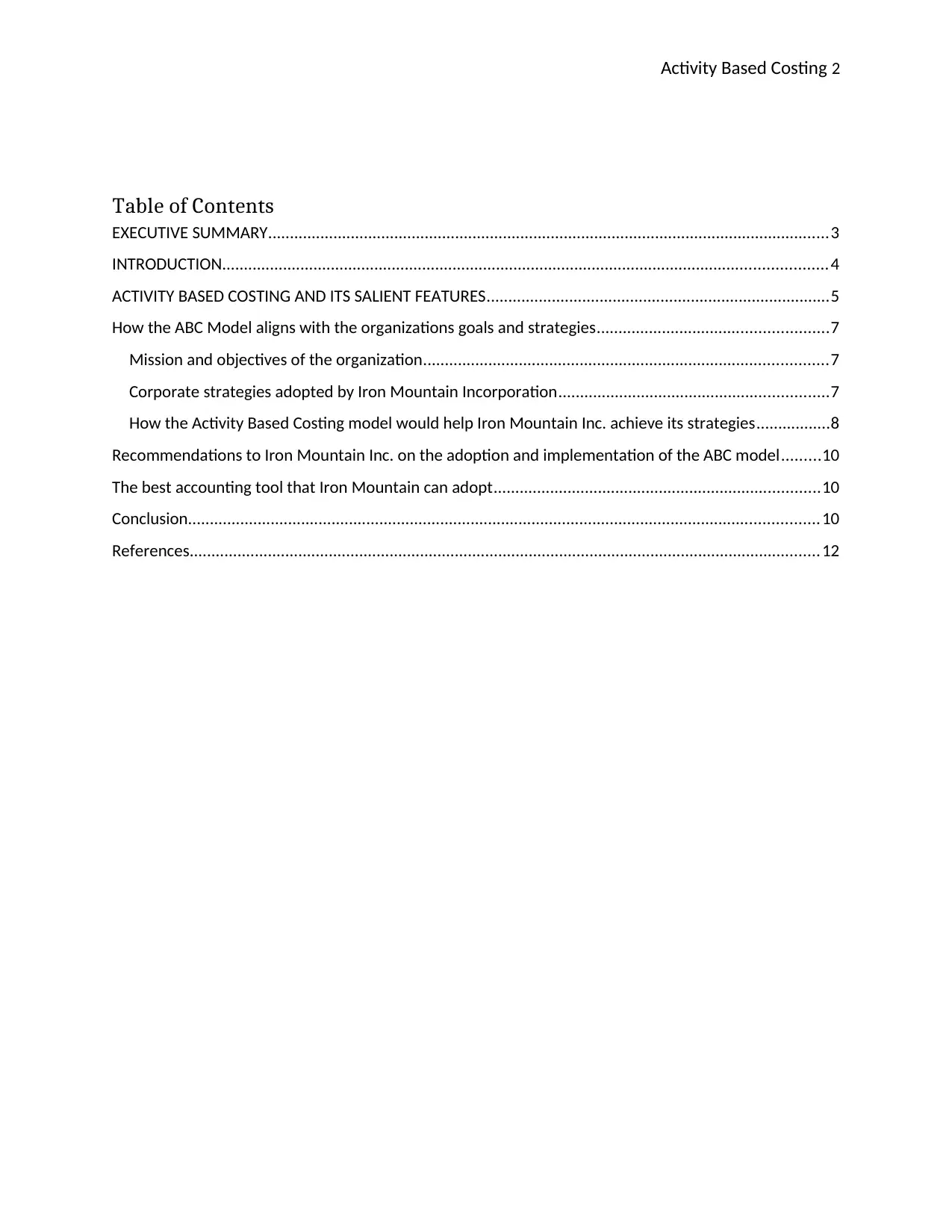
Activity Based Costing 2
Table of Contents
EXECUTIVE SUMMARY.................................................................................................................................3
INTRODUCTION...........................................................................................................................................4
ACTIVITY BASED COSTING AND ITS SALIENT FEATURES...............................................................................5
How the ABC Model aligns with the organizations goals and strategies.....................................................7
Mission and objectives of the organization.............................................................................................7
Corporate strategies adopted by Iron Mountain Incorporation..............................................................7
How the Activity Based Costing model would help Iron Mountain Inc. achieve its strategies.................8
Recommendations to Iron Mountain Inc. on the adoption and implementation of the ABC model.........10
The best accounting tool that Iron Mountain can adopt...........................................................................10
Conclusion.................................................................................................................................................10
References.................................................................................................................................................12
Table of Contents
EXECUTIVE SUMMARY.................................................................................................................................3
INTRODUCTION...........................................................................................................................................4
ACTIVITY BASED COSTING AND ITS SALIENT FEATURES...............................................................................5
How the ABC Model aligns with the organizations goals and strategies.....................................................7
Mission and objectives of the organization.............................................................................................7
Corporate strategies adopted by Iron Mountain Incorporation..............................................................7
How the Activity Based Costing model would help Iron Mountain Inc. achieve its strategies.................8
Recommendations to Iron Mountain Inc. on the adoption and implementation of the ABC model.........10
The best accounting tool that Iron Mountain can adopt...........................................................................10
Conclusion.................................................................................................................................................10
References.................................................................................................................................................12
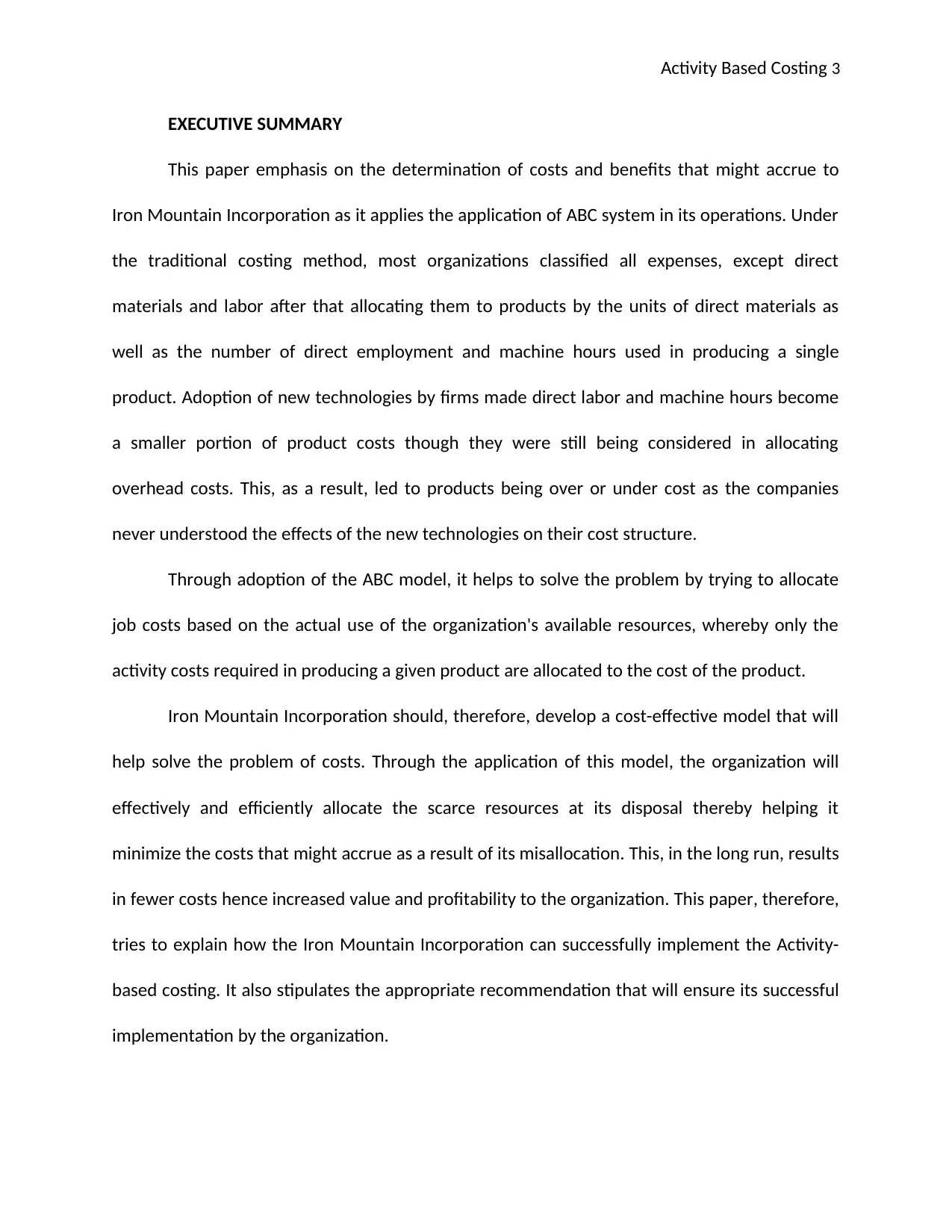
Activity Based Costing 3
EXECUTIVE SUMMARY
This paper emphasis on the determination of costs and benefits that might accrue to
Iron Mountain Incorporation as it applies the application of ABC system in its operations. Under
the traditional costing method, most organizations classified all expenses, except direct
materials and labor after that allocating them to products by the units of direct materials as
well as the number of direct employment and machine hours used in producing a single
product. Adoption of new technologies by firms made direct labor and machine hours become
a smaller portion of product costs though they were still being considered in allocating
overhead costs. This, as a result, led to products being over or under cost as the companies
never understood the effects of the new technologies on their cost structure.
Through adoption of the ABC model, it helps to solve the problem by trying to allocate
job costs based on the actual use of the organization's available resources, whereby only the
activity costs required in producing a given product are allocated to the cost of the product.
Iron Mountain Incorporation should, therefore, develop a cost-effective model that will
help solve the problem of costs. Through the application of this model, the organization will
effectively and efficiently allocate the scarce resources at its disposal thereby helping it
minimize the costs that might accrue as a result of its misallocation. This, in the long run, results
in fewer costs hence increased value and profitability to the organization. This paper, therefore,
tries to explain how the Iron Mountain Incorporation can successfully implement the Activity-
based costing. It also stipulates the appropriate recommendation that will ensure its successful
implementation by the organization.
EXECUTIVE SUMMARY
This paper emphasis on the determination of costs and benefits that might accrue to
Iron Mountain Incorporation as it applies the application of ABC system in its operations. Under
the traditional costing method, most organizations classified all expenses, except direct
materials and labor after that allocating them to products by the units of direct materials as
well as the number of direct employment and machine hours used in producing a single
product. Adoption of new technologies by firms made direct labor and machine hours become
a smaller portion of product costs though they were still being considered in allocating
overhead costs. This, as a result, led to products being over or under cost as the companies
never understood the effects of the new technologies on their cost structure.
Through adoption of the ABC model, it helps to solve the problem by trying to allocate
job costs based on the actual use of the organization's available resources, whereby only the
activity costs required in producing a given product are allocated to the cost of the product.
Iron Mountain Incorporation should, therefore, develop a cost-effective model that will
help solve the problem of costs. Through the application of this model, the organization will
effectively and efficiently allocate the scarce resources at its disposal thereby helping it
minimize the costs that might accrue as a result of its misallocation. This, in the long run, results
in fewer costs hence increased value and profitability to the organization. This paper, therefore,
tries to explain how the Iron Mountain Incorporation can successfully implement the Activity-
based costing. It also stipulates the appropriate recommendation that will ensure its successful
implementation by the organization.
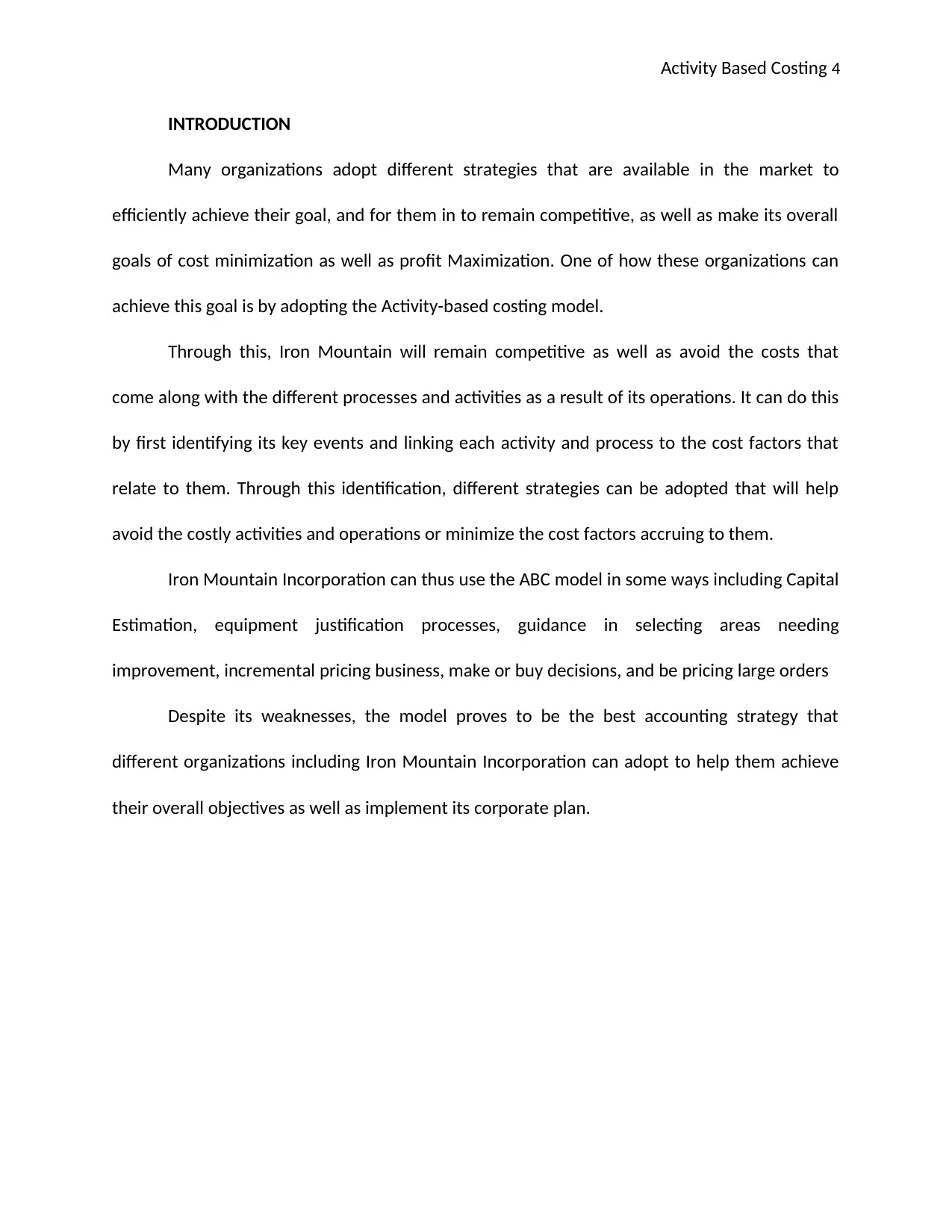
Activity Based Costing 4
INTRODUCTION
Many organizations adopt different strategies that are available in the market to
efficiently achieve their goal, and for them in to remain competitive, as well as make its overall
goals of cost minimization as well as profit Maximization. One of how these organizations can
achieve this goal is by adopting the Activity-based costing model.
Through this, Iron Mountain will remain competitive as well as avoid the costs that
come along with the different processes and activities as a result of its operations. It can do this
by first identifying its key events and linking each activity and process to the cost factors that
relate to them. Through this identification, different strategies can be adopted that will help
avoid the costly activities and operations or minimize the cost factors accruing to them.
Iron Mountain Incorporation can thus use the ABC model in some ways including Capital
Estimation, equipment justification processes, guidance in selecting areas needing
improvement, incremental pricing business, make or buy decisions, and be pricing large orders
Despite its weaknesses, the model proves to be the best accounting strategy that
different organizations including Iron Mountain Incorporation can adopt to help them achieve
their overall objectives as well as implement its corporate plan.
INTRODUCTION
Many organizations adopt different strategies that are available in the market to
efficiently achieve their goal, and for them in to remain competitive, as well as make its overall
goals of cost minimization as well as profit Maximization. One of how these organizations can
achieve this goal is by adopting the Activity-based costing model.
Through this, Iron Mountain will remain competitive as well as avoid the costs that
come along with the different processes and activities as a result of its operations. It can do this
by first identifying its key events and linking each activity and process to the cost factors that
relate to them. Through this identification, different strategies can be adopted that will help
avoid the costly activities and operations or minimize the cost factors accruing to them.
Iron Mountain Incorporation can thus use the ABC model in some ways including Capital
Estimation, equipment justification processes, guidance in selecting areas needing
improvement, incremental pricing business, make or buy decisions, and be pricing large orders
Despite its weaknesses, the model proves to be the best accounting strategy that
different organizations including Iron Mountain Incorporation can adopt to help them achieve
their overall objectives as well as implement its corporate plan.
Secure Best Marks with AI Grader
Need help grading? Try our AI Grader for instant feedback on your assignments.
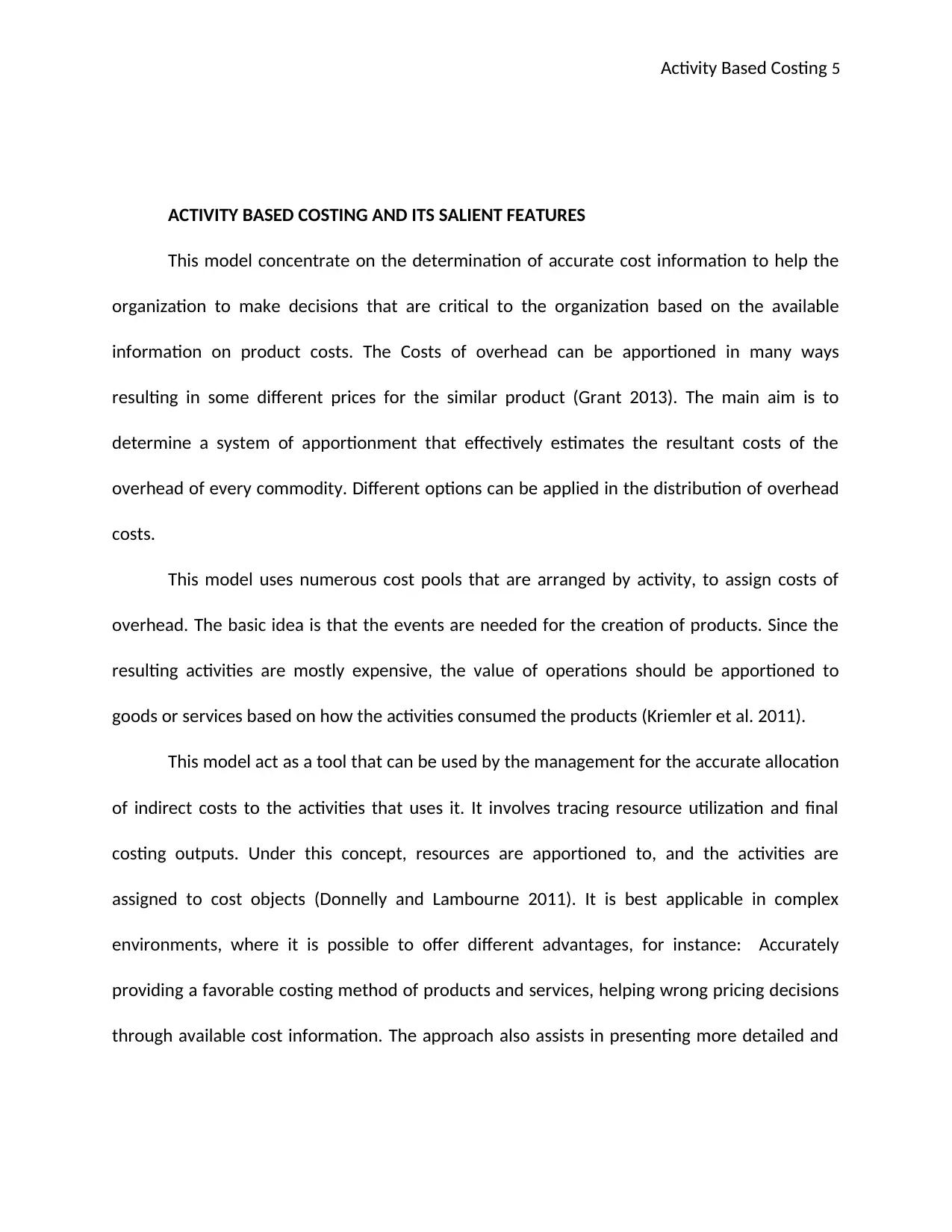
Activity Based Costing 5
ACTIVITY BASED COSTING AND ITS SALIENT FEATURES
This model concentrate on the determination of accurate cost information to help the
organization to make decisions that are critical to the organization based on the available
information on product costs. The Costs of overhead can be apportioned in many ways
resulting in some different prices for the similar product (Grant 2013). The main aim is to
determine a system of apportionment that effectively estimates the resultant costs of the
overhead of every commodity. Different options can be applied in the distribution of overhead
costs.
This model uses numerous cost pools that are arranged by activity, to assign costs of
overhead. The basic idea is that the events are needed for the creation of products. Since the
resulting activities are mostly expensive, the value of operations should be apportioned to
goods or services based on how the activities consumed the products (Kriemler et al. 2011).
This model act as a tool that can be used by the management for the accurate allocation
of indirect costs to the activities that uses it. It involves tracing resource utilization and final
costing outputs. Under this concept, resources are apportioned to, and the activities are
assigned to cost objects (Donnelly and Lambourne 2011). It is best applicable in complex
environments, where it is possible to offer different advantages, for instance: Accurately
providing a favorable costing method of products and services, helping wrong pricing decisions
through available cost information. The approach also assists in presenting more detailed and
ACTIVITY BASED COSTING AND ITS SALIENT FEATURES
This model concentrate on the determination of accurate cost information to help the
organization to make decisions that are critical to the organization based on the available
information on product costs. The Costs of overhead can be apportioned in many ways
resulting in some different prices for the similar product (Grant 2013). The main aim is to
determine a system of apportionment that effectively estimates the resultant costs of the
overhead of every commodity. Different options can be applied in the distribution of overhead
costs.
This model uses numerous cost pools that are arranged by activity, to assign costs of
overhead. The basic idea is that the events are needed for the creation of products. Since the
resulting activities are mostly expensive, the value of operations should be apportioned to
goods or services based on how the activities consumed the products (Kriemler et al. 2011).
This model act as a tool that can be used by the management for the accurate allocation
of indirect costs to the activities that uses it. It involves tracing resource utilization and final
costing outputs. Under this concept, resources are apportioned to, and the activities are
assigned to cost objects (Donnelly and Lambourne 2011). It is best applicable in complex
environments, where it is possible to offer different advantages, for instance: Accurately
providing a favorable costing method of products and services, helping wrong pricing decisions
through available cost information. The approach also assists in presenting more detailed and
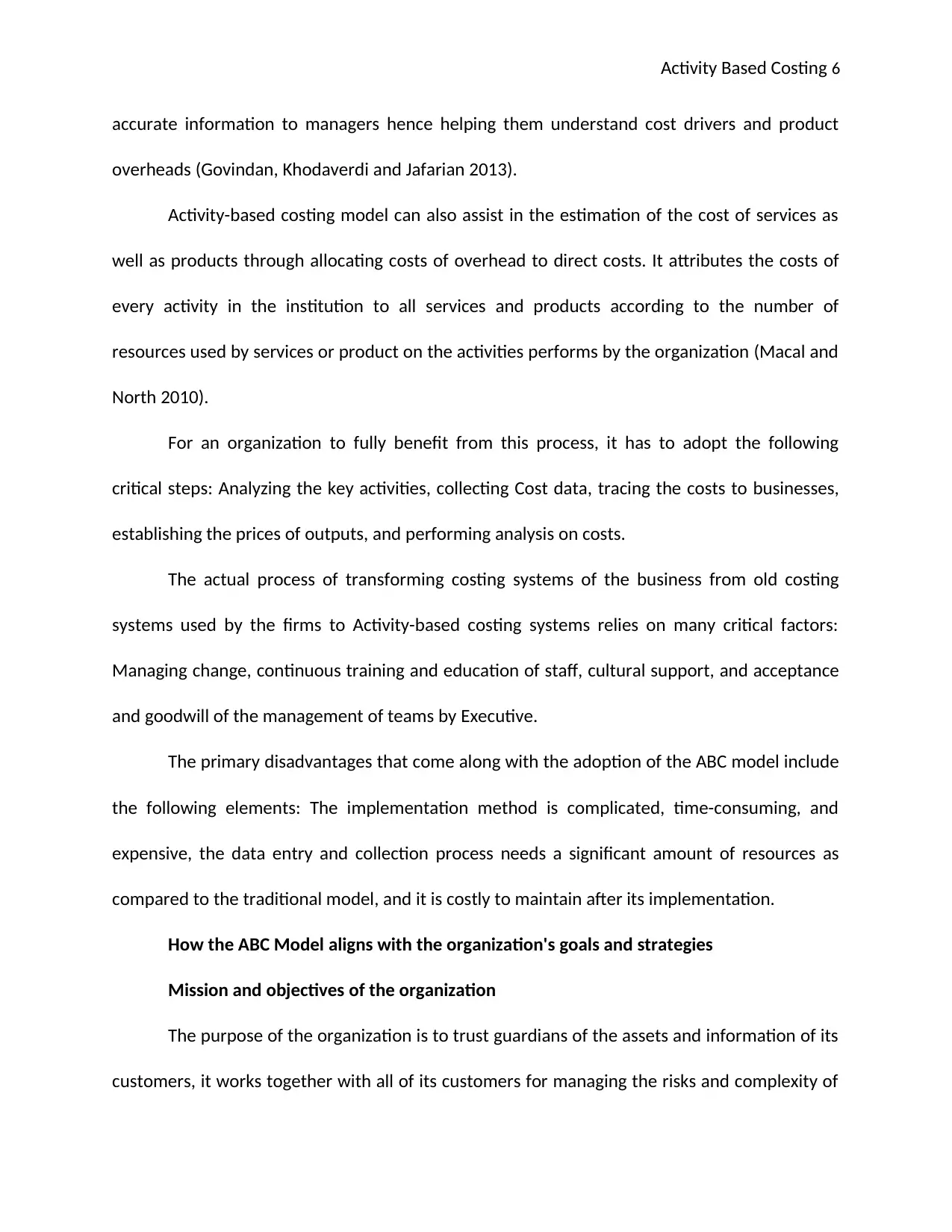
Activity Based Costing 6
accurate information to managers hence helping them understand cost drivers and product
overheads (Govindan, Khodaverdi and Jafarian 2013).
Activity-based costing model can also assist in the estimation of the cost of services as
well as products through allocating costs of overhead to direct costs. It attributes the costs of
every activity in the institution to all services and products according to the number of
resources used by services or product on the activities performs by the organization (Macal and
North 2010).
For an organization to fully benefit from this process, it has to adopt the following
critical steps: Analyzing the key activities, collecting Cost data, tracing the costs to businesses,
establishing the prices of outputs, and performing analysis on costs.
The actual process of transforming costing systems of the business from old costing
systems used by the firms to Activity-based costing systems relies on many critical factors:
Managing change, continuous training and education of staff, cultural support, and acceptance
and goodwill of the management of teams by Executive.
The primary disadvantages that come along with the adoption of the ABC model include
the following elements: The implementation method is complicated, time-consuming, and
expensive, the data entry and collection process needs a significant amount of resources as
compared to the traditional model, and it is costly to maintain after its implementation.
How the ABC Model aligns with the organization's goals and strategies
Mission and objectives of the organization
The purpose of the organization is to trust guardians of the assets and information of its
customers, it works together with all of its customers for managing the risks and complexity of
accurate information to managers hence helping them understand cost drivers and product
overheads (Govindan, Khodaverdi and Jafarian 2013).
Activity-based costing model can also assist in the estimation of the cost of services as
well as products through allocating costs of overhead to direct costs. It attributes the costs of
every activity in the institution to all services and products according to the number of
resources used by services or product on the activities performs by the organization (Macal and
North 2010).
For an organization to fully benefit from this process, it has to adopt the following
critical steps: Analyzing the key activities, collecting Cost data, tracing the costs to businesses,
establishing the prices of outputs, and performing analysis on costs.
The actual process of transforming costing systems of the business from old costing
systems used by the firms to Activity-based costing systems relies on many critical factors:
Managing change, continuous training and education of staff, cultural support, and acceptance
and goodwill of the management of teams by Executive.
The primary disadvantages that come along with the adoption of the ABC model include
the following elements: The implementation method is complicated, time-consuming, and
expensive, the data entry and collection process needs a significant amount of resources as
compared to the traditional model, and it is costly to maintain after its implementation.
How the ABC Model aligns with the organization's goals and strategies
Mission and objectives of the organization
The purpose of the organization is to trust guardians of the assets and information of its
customers, it works together with all of its customers for managing the risks and complexity of
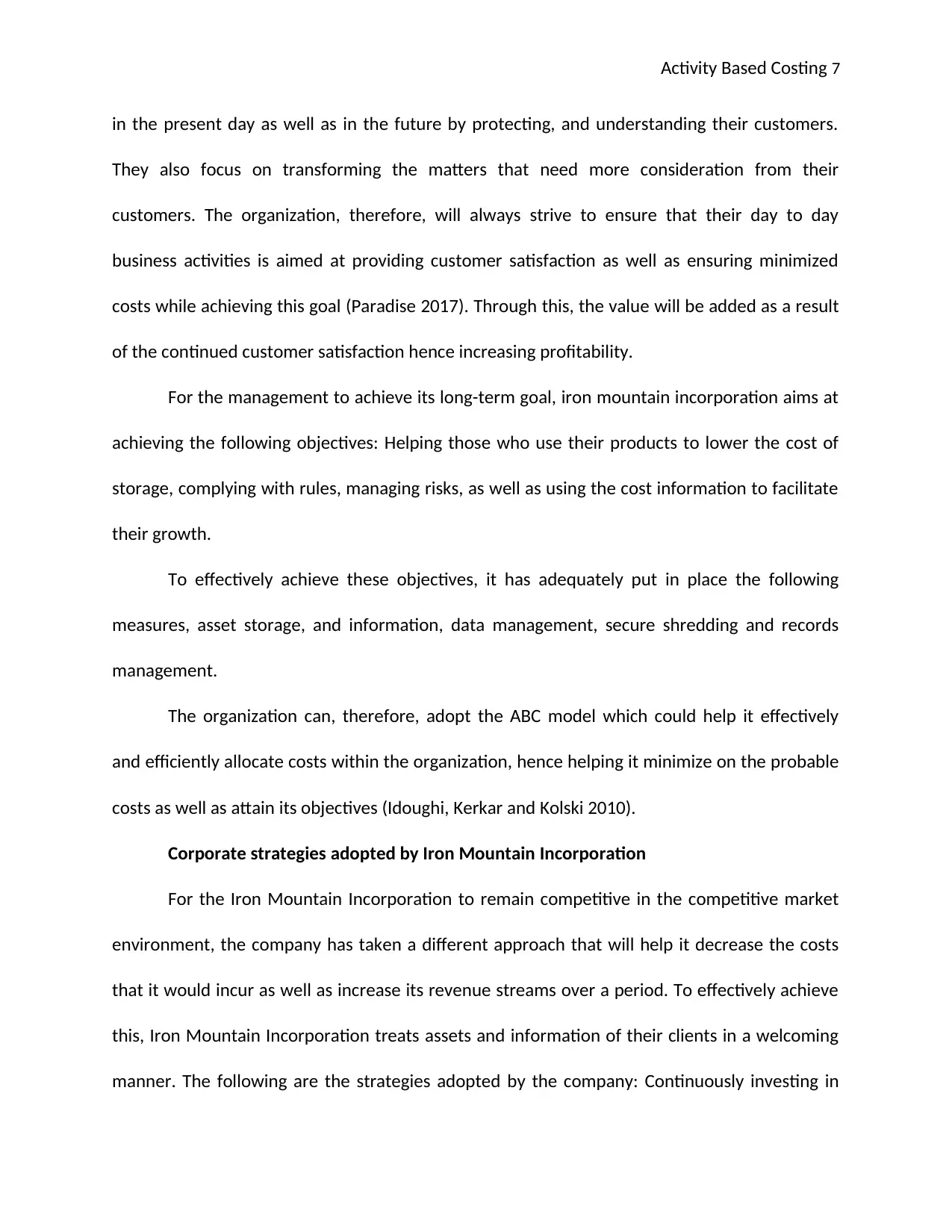
Activity Based Costing 7
in the present day as well as in the future by protecting, and understanding their customers.
They also focus on transforming the matters that need more consideration from their
customers. The organization, therefore, will always strive to ensure that their day to day
business activities is aimed at providing customer satisfaction as well as ensuring minimized
costs while achieving this goal (Paradise 2017). Through this, the value will be added as a result
of the continued customer satisfaction hence increasing profitability.
For the management to achieve its long-term goal, iron mountain incorporation aims at
achieving the following objectives: Helping those who use their products to lower the cost of
storage, complying with rules, managing risks, as well as using the cost information to facilitate
their growth.
To effectively achieve these objectives, it has adequately put in place the following
measures, asset storage, and information, data management, secure shredding and records
management.
The organization can, therefore, adopt the ABC model which could help it effectively
and efficiently allocate costs within the organization, hence helping it minimize on the probable
costs as well as attain its objectives (Idoughi, Kerkar and Kolski 2010).
Corporate strategies adopted by Iron Mountain Incorporation
For the Iron Mountain Incorporation to remain competitive in the competitive market
environment, the company has taken a different approach that will help it decrease the costs
that it would incur as well as increase its revenue streams over a period. To effectively achieve
this, Iron Mountain Incorporation treats assets and information of their clients in a welcoming
manner. The following are the strategies adopted by the company: Continuously investing in
in the present day as well as in the future by protecting, and understanding their customers.
They also focus on transforming the matters that need more consideration from their
customers. The organization, therefore, will always strive to ensure that their day to day
business activities is aimed at providing customer satisfaction as well as ensuring minimized
costs while achieving this goal (Paradise 2017). Through this, the value will be added as a result
of the continued customer satisfaction hence increasing profitability.
For the management to achieve its long-term goal, iron mountain incorporation aims at
achieving the following objectives: Helping those who use their products to lower the cost of
storage, complying with rules, managing risks, as well as using the cost information to facilitate
their growth.
To effectively achieve these objectives, it has adequately put in place the following
measures, asset storage, and information, data management, secure shredding and records
management.
The organization can, therefore, adopt the ABC model which could help it effectively
and efficiently allocate costs within the organization, hence helping it minimize on the probable
costs as well as attain its objectives (Idoughi, Kerkar and Kolski 2010).
Corporate strategies adopted by Iron Mountain Incorporation
For the Iron Mountain Incorporation to remain competitive in the competitive market
environment, the company has taken a different approach that will help it decrease the costs
that it would incur as well as increase its revenue streams over a period. To effectively achieve
this, Iron Mountain Incorporation treats assets and information of their clients in a welcoming
manner. The following are the strategies adopted by the company: Continuously investing in
Paraphrase This Document
Need a fresh take? Get an instant paraphrase of this document with our AI Paraphraser
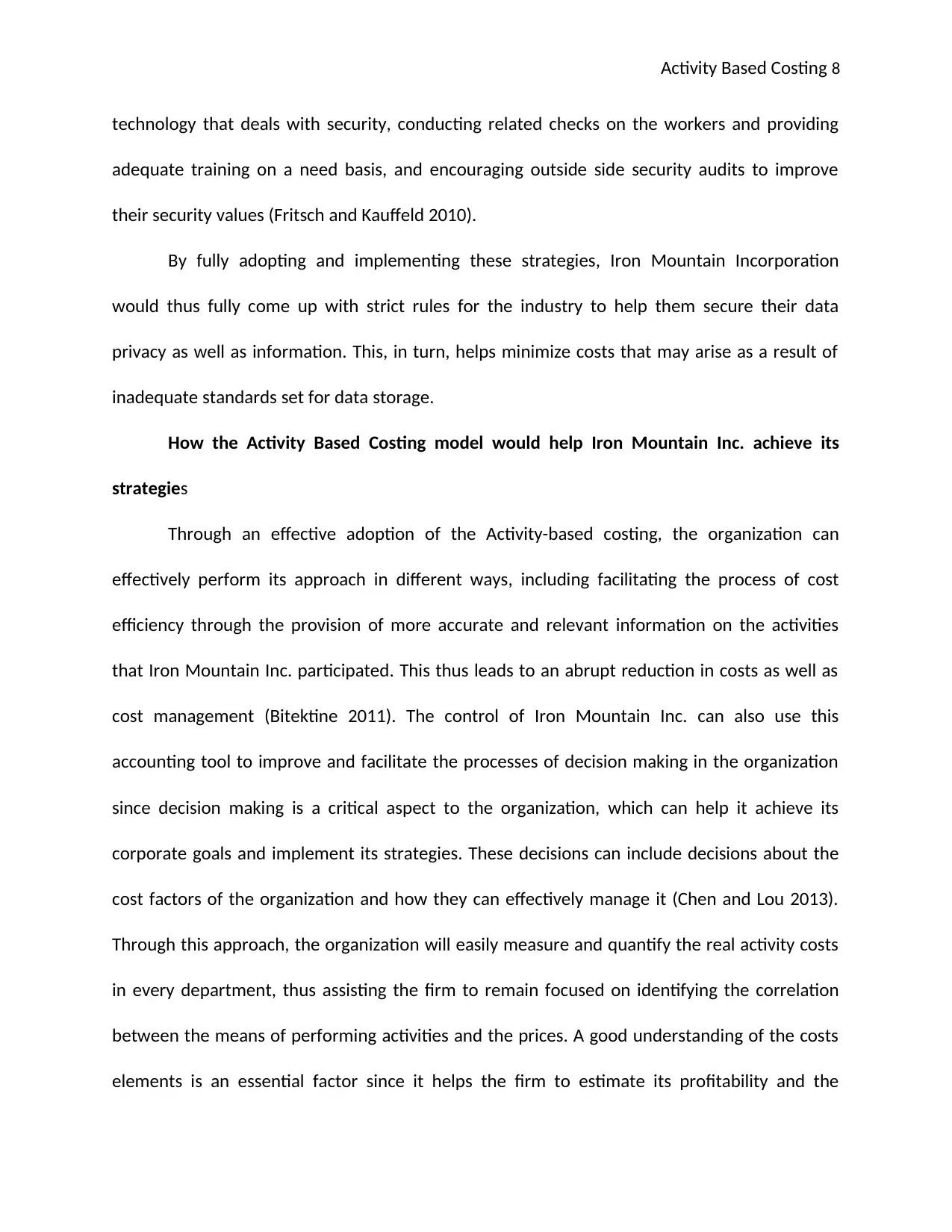
Activity Based Costing 8
technology that deals with security, conducting related checks on the workers and providing
adequate training on a need basis, and encouraging outside side security audits to improve
their security values (Fritsch and Kauffeld 2010).
By fully adopting and implementing these strategies, Iron Mountain Incorporation
would thus fully come up with strict rules for the industry to help them secure their data
privacy as well as information. This, in turn, helps minimize costs that may arise as a result of
inadequate standards set for data storage.
How the Activity Based Costing model would help Iron Mountain Inc. achieve its
strategies
Through an effective adoption of the Activity-based costing, the organization can
effectively perform its approach in different ways, including facilitating the process of cost
efficiency through the provision of more accurate and relevant information on the activities
that Iron Mountain Inc. participated. This thus leads to an abrupt reduction in costs as well as
cost management (Bitektine 2011). The control of Iron Mountain Inc. can also use this
accounting tool to improve and facilitate the processes of decision making in the organization
since decision making is a critical aspect to the organization, which can help it achieve its
corporate goals and implement its strategies. These decisions can include decisions about the
cost factors of the organization and how they can effectively manage it (Chen and Lou 2013).
Through this approach, the organization will easily measure and quantify the real activity costs
in every department, thus assisting the firm to remain focused on identifying the correlation
between the means of performing activities and the prices. A good understanding of the costs
elements is an essential factor since it helps the firm to estimate its profitability and the
technology that deals with security, conducting related checks on the workers and providing
adequate training on a need basis, and encouraging outside side security audits to improve
their security values (Fritsch and Kauffeld 2010).
By fully adopting and implementing these strategies, Iron Mountain Incorporation
would thus fully come up with strict rules for the industry to help them secure their data
privacy as well as information. This, in turn, helps minimize costs that may arise as a result of
inadequate standards set for data storage.
How the Activity Based Costing model would help Iron Mountain Inc. achieve its
strategies
Through an effective adoption of the Activity-based costing, the organization can
effectively perform its approach in different ways, including facilitating the process of cost
efficiency through the provision of more accurate and relevant information on the activities
that Iron Mountain Inc. participated. This thus leads to an abrupt reduction in costs as well as
cost management (Bitektine 2011). The control of Iron Mountain Inc. can also use this
accounting tool to improve and facilitate the processes of decision making in the organization
since decision making is a critical aspect to the organization, which can help it achieve its
corporate goals and implement its strategies. These decisions can include decisions about the
cost factors of the organization and how they can effectively manage it (Chen and Lou 2013).
Through this approach, the organization will easily measure and quantify the real activity costs
in every department, thus assisting the firm to remain focused on identifying the correlation
between the means of performing activities and the prices. A good understanding of the costs
elements is an essential factor since it helps the firm to estimate its profitability and the
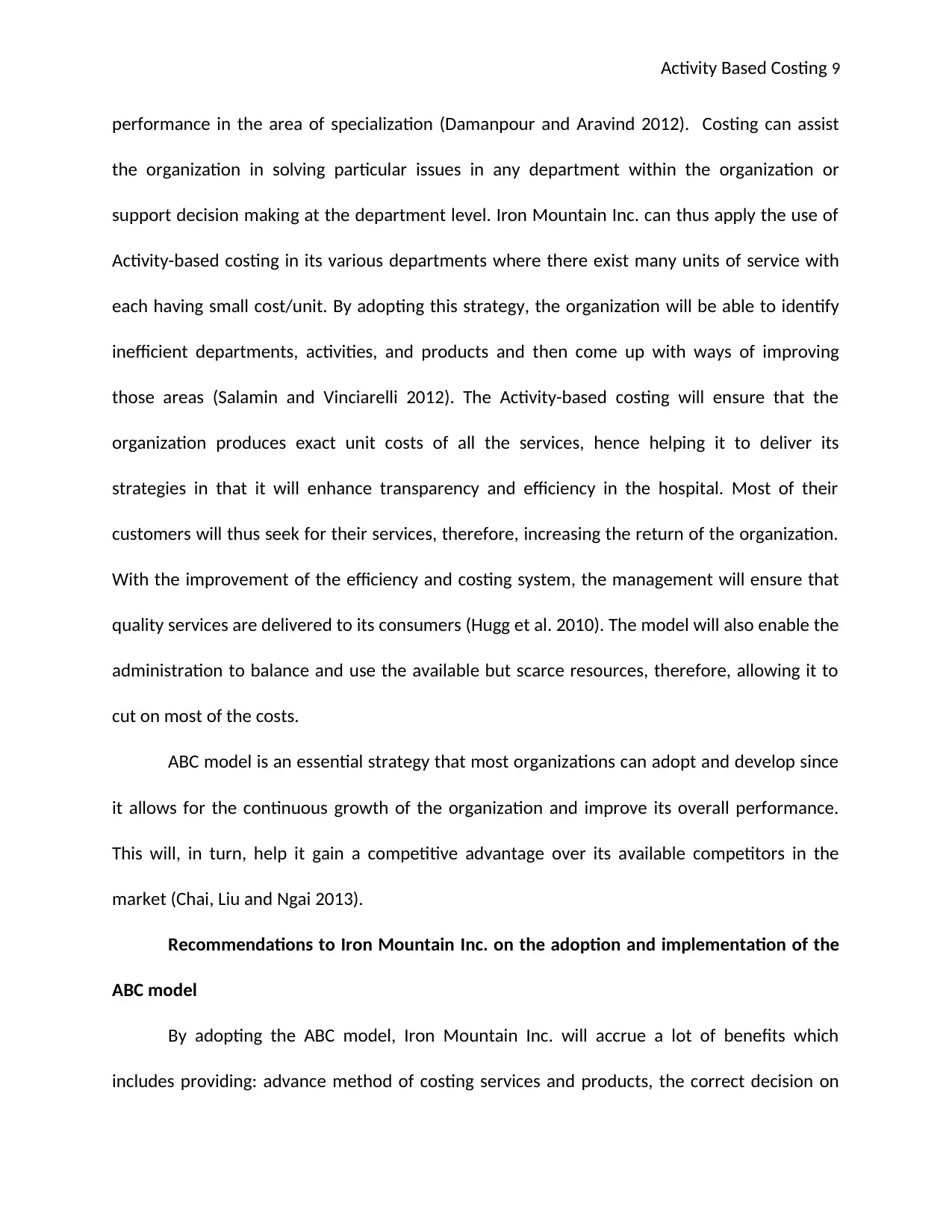
Activity Based Costing 9
performance in the area of specialization (Damanpour and Aravind 2012). Costing can assist
the organization in solving particular issues in any department within the organization or
support decision making at the department level. Iron Mountain Inc. can thus apply the use of
Activity-based costing in its various departments where there exist many units of service with
each having small cost/unit. By adopting this strategy, the organization will be able to identify
inefficient departments, activities, and products and then come up with ways of improving
those areas (Salamin and Vinciarelli 2012). The Activity-based costing will ensure that the
organization produces exact unit costs of all the services, hence helping it to deliver its
strategies in that it will enhance transparency and efficiency in the hospital. Most of their
customers will thus seek for their services, therefore, increasing the return of the organization.
With the improvement of the efficiency and costing system, the management will ensure that
quality services are delivered to its consumers (Hugg et al. 2010). The model will also enable the
administration to balance and use the available but scarce resources, therefore, allowing it to
cut on most of the costs.
ABC model is an essential strategy that most organizations can adopt and develop since
it allows for the continuous growth of the organization and improve its overall performance.
This will, in turn, help it gain a competitive advantage over its available competitors in the
market (Chai, Liu and Ngai 2013).
Recommendations to Iron Mountain Inc. on the adoption and implementation of the
ABC model
By adopting the ABC model, Iron Mountain Inc. will accrue a lot of benefits which
includes providing: advance method of costing services and products, the correct decision on
performance in the area of specialization (Damanpour and Aravind 2012). Costing can assist
the organization in solving particular issues in any department within the organization or
support decision making at the department level. Iron Mountain Inc. can thus apply the use of
Activity-based costing in its various departments where there exist many units of service with
each having small cost/unit. By adopting this strategy, the organization will be able to identify
inefficient departments, activities, and products and then come up with ways of improving
those areas (Salamin and Vinciarelli 2012). The Activity-based costing will ensure that the
organization produces exact unit costs of all the services, hence helping it to deliver its
strategies in that it will enhance transparency and efficiency in the hospital. Most of their
customers will thus seek for their services, therefore, increasing the return of the organization.
With the improvement of the efficiency and costing system, the management will ensure that
quality services are delivered to its consumers (Hugg et al. 2010). The model will also enable the
administration to balance and use the available but scarce resources, therefore, allowing it to
cut on most of the costs.
ABC model is an essential strategy that most organizations can adopt and develop since
it allows for the continuous growth of the organization and improve its overall performance.
This will, in turn, help it gain a competitive advantage over its available competitors in the
market (Chai, Liu and Ngai 2013).
Recommendations to Iron Mountain Inc. on the adoption and implementation of the
ABC model
By adopting the ABC model, Iron Mountain Inc. will accrue a lot of benefits which
includes providing: advance method of costing services and products, the correct decision on
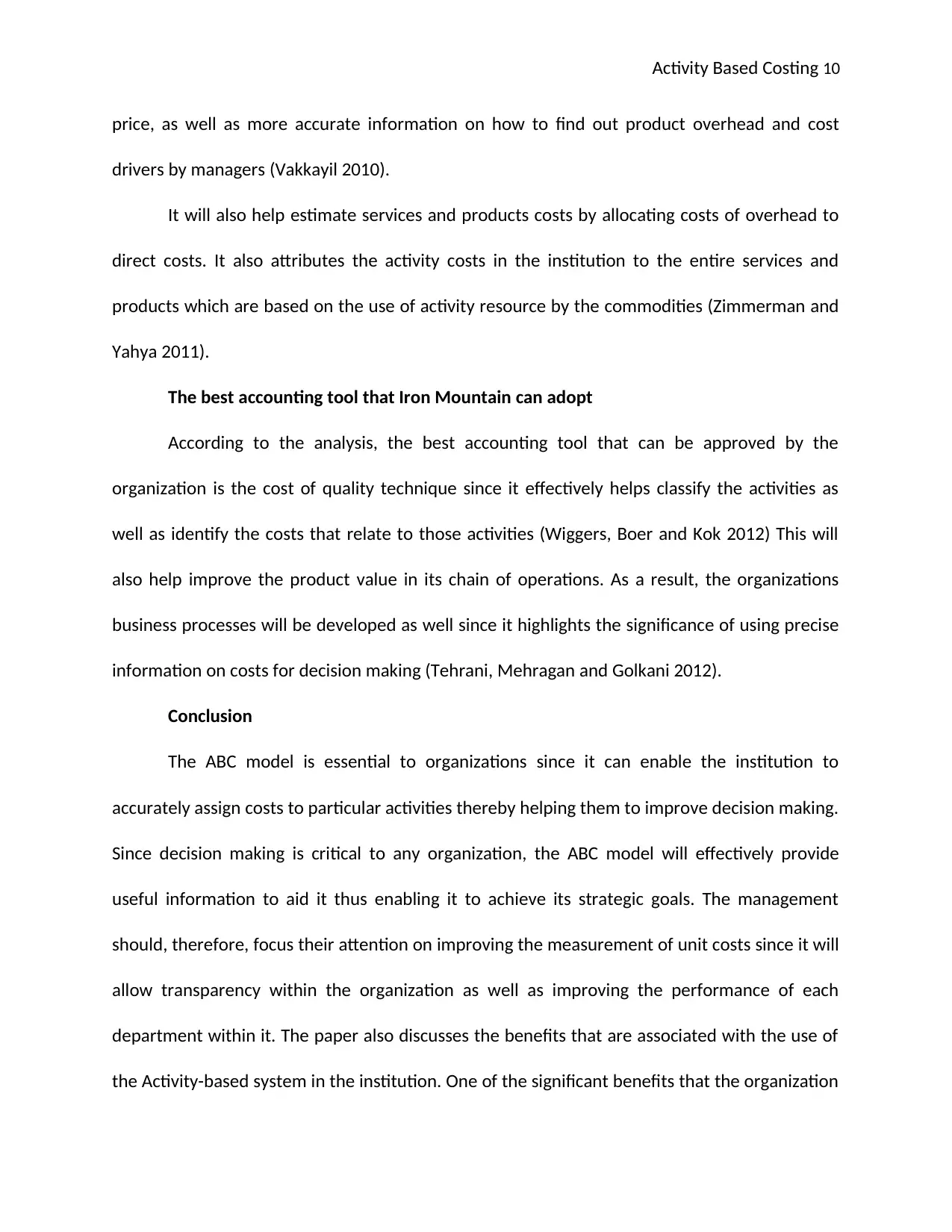
Activity Based Costing 10
price, as well as more accurate information on how to find out product overhead and cost
drivers by managers (Vakkayil 2010).
It will also help estimate services and products costs by allocating costs of overhead to
direct costs. It also attributes the activity costs in the institution to the entire services and
products which are based on the use of activity resource by the commodities (Zimmerman and
Yahya 2011).
The best accounting tool that Iron Mountain can adopt
According to the analysis, the best accounting tool that can be approved by the
organization is the cost of quality technique since it effectively helps classify the activities as
well as identify the costs that relate to those activities (Wiggers, Boer and Kok 2012) This will
also help improve the product value in its chain of operations. As a result, the organizations
business processes will be developed as well since it highlights the significance of using precise
information on costs for decision making (Tehrani, Mehragan and Golkani 2012).
Conclusion
The ABC model is essential to organizations since it can enable the institution to
accurately assign costs to particular activities thereby helping them to improve decision making.
Since decision making is critical to any organization, the ABC model will effectively provide
useful information to aid it thus enabling it to achieve its strategic goals. The management
should, therefore, focus their attention on improving the measurement of unit costs since it will
allow transparency within the organization as well as improving the performance of each
department within it. The paper also discusses the benefits that are associated with the use of
the Activity-based system in the institution. One of the significant benefits that the organization
price, as well as more accurate information on how to find out product overhead and cost
drivers by managers (Vakkayil 2010).
It will also help estimate services and products costs by allocating costs of overhead to
direct costs. It also attributes the activity costs in the institution to the entire services and
products which are based on the use of activity resource by the commodities (Zimmerman and
Yahya 2011).
The best accounting tool that Iron Mountain can adopt
According to the analysis, the best accounting tool that can be approved by the
organization is the cost of quality technique since it effectively helps classify the activities as
well as identify the costs that relate to those activities (Wiggers, Boer and Kok 2012) This will
also help improve the product value in its chain of operations. As a result, the organizations
business processes will be developed as well since it highlights the significance of using precise
information on costs for decision making (Tehrani, Mehragan and Golkani 2012).
Conclusion
The ABC model is essential to organizations since it can enable the institution to
accurately assign costs to particular activities thereby helping them to improve decision making.
Since decision making is critical to any organization, the ABC model will effectively provide
useful information to aid it thus enabling it to achieve its strategic goals. The management
should, therefore, focus their attention on improving the measurement of unit costs since it will
allow transparency within the organization as well as improving the performance of each
department within it. The paper also discusses the benefits that are associated with the use of
the Activity-based system in the institution. One of the significant benefits that the organization
Secure Best Marks with AI Grader
Need help grading? Try our AI Grader for instant feedback on your assignments.
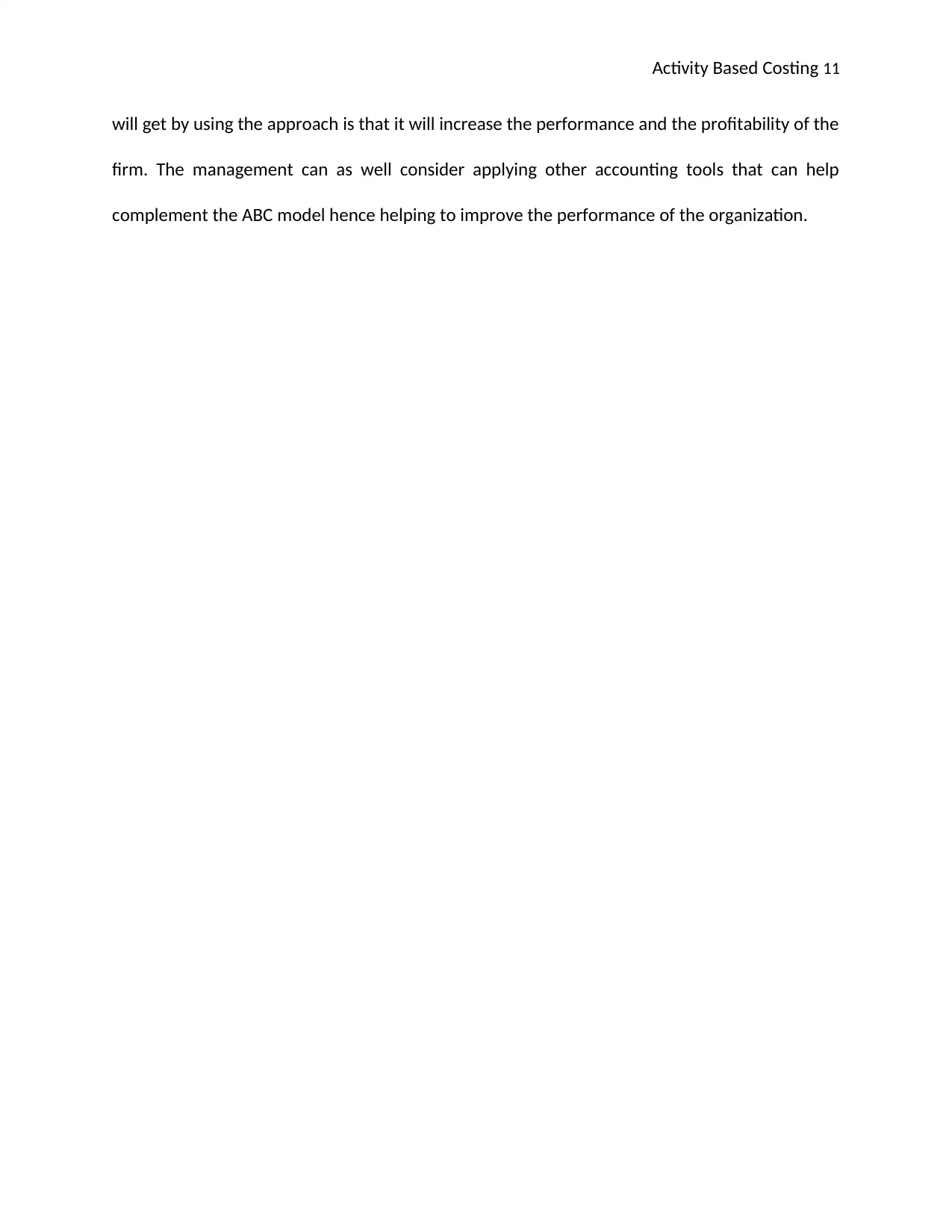
Activity Based Costing 11
will get by using the approach is that it will increase the performance and the profitability of the
firm. The management can as well consider applying other accounting tools that can help
complement the ABC model hence helping to improve the performance of the organization.
will get by using the approach is that it will increase the performance and the profitability of the
firm. The management can as well consider applying other accounting tools that can help
complement the ABC model hence helping to improve the performance of the organization.
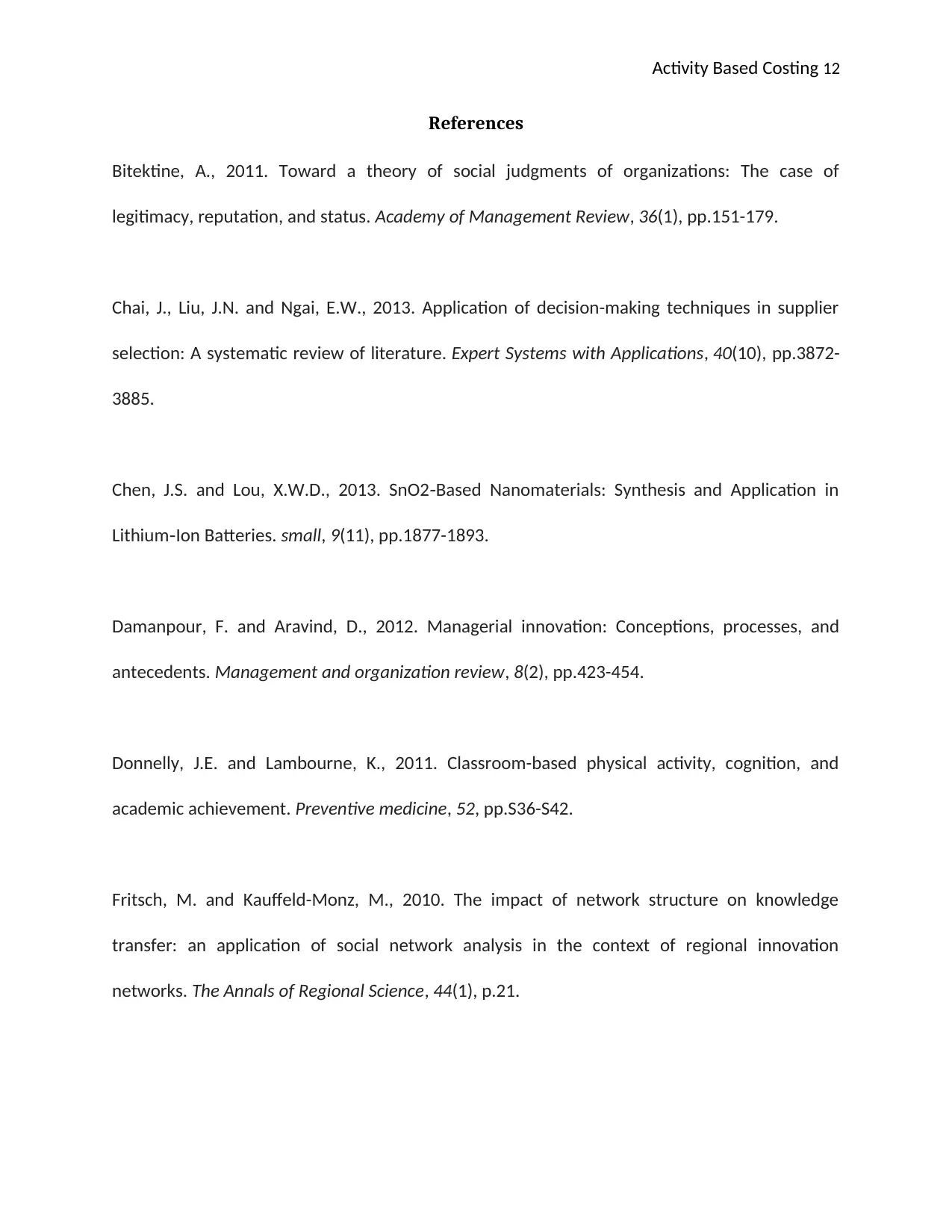
Activity Based Costing 12
References
Bitektine, A., 2011. Toward a theory of social judgments of organizations: The case of
legitimacy, reputation, and status. Academy of Management Review, 36(1), pp.151-179.
Chai, J., Liu, J.N. and Ngai, E.W., 2013. Application of decision-making techniques in supplier
selection: A systematic review of literature. Expert Systems with Applications, 40(10), pp.3872-
3885.
Chen, J.S. and Lou, X.W.D., 2013. SnO2 Based Nanomaterials: Synthesis and Application in‐
Lithium Ion Batteries.‐ small, 9(11), pp.1877-1893.
Damanpour, F. and Aravind, D., 2012. Managerial innovation: Conceptions, processes, and
antecedents. Management and organization review, 8(2), pp.423-454.
Donnelly, J.E. and Lambourne, K., 2011. Classroom-based physical activity, cognition, and
academic achievement. Preventive medicine, 52, pp.S36-S42.
Fritsch, M. and Kauffeld-Monz, M., 2010. The impact of network structure on knowledge
transfer: an application of social network analysis in the context of regional innovation
networks. The Annals of Regional Science, 44(1), p.21.
References
Bitektine, A., 2011. Toward a theory of social judgments of organizations: The case of
legitimacy, reputation, and status. Academy of Management Review, 36(1), pp.151-179.
Chai, J., Liu, J.N. and Ngai, E.W., 2013. Application of decision-making techniques in supplier
selection: A systematic review of literature. Expert Systems with Applications, 40(10), pp.3872-
3885.
Chen, J.S. and Lou, X.W.D., 2013. SnO2 Based Nanomaterials: Synthesis and Application in‐
Lithium Ion Batteries.‐ small, 9(11), pp.1877-1893.
Damanpour, F. and Aravind, D., 2012. Managerial innovation: Conceptions, processes, and
antecedents. Management and organization review, 8(2), pp.423-454.
Donnelly, J.E. and Lambourne, K., 2011. Classroom-based physical activity, cognition, and
academic achievement. Preventive medicine, 52, pp.S36-S42.
Fritsch, M. and Kauffeld-Monz, M., 2010. The impact of network structure on knowledge
transfer: an application of social network analysis in the context of regional innovation
networks. The Annals of Regional Science, 44(1), p.21.
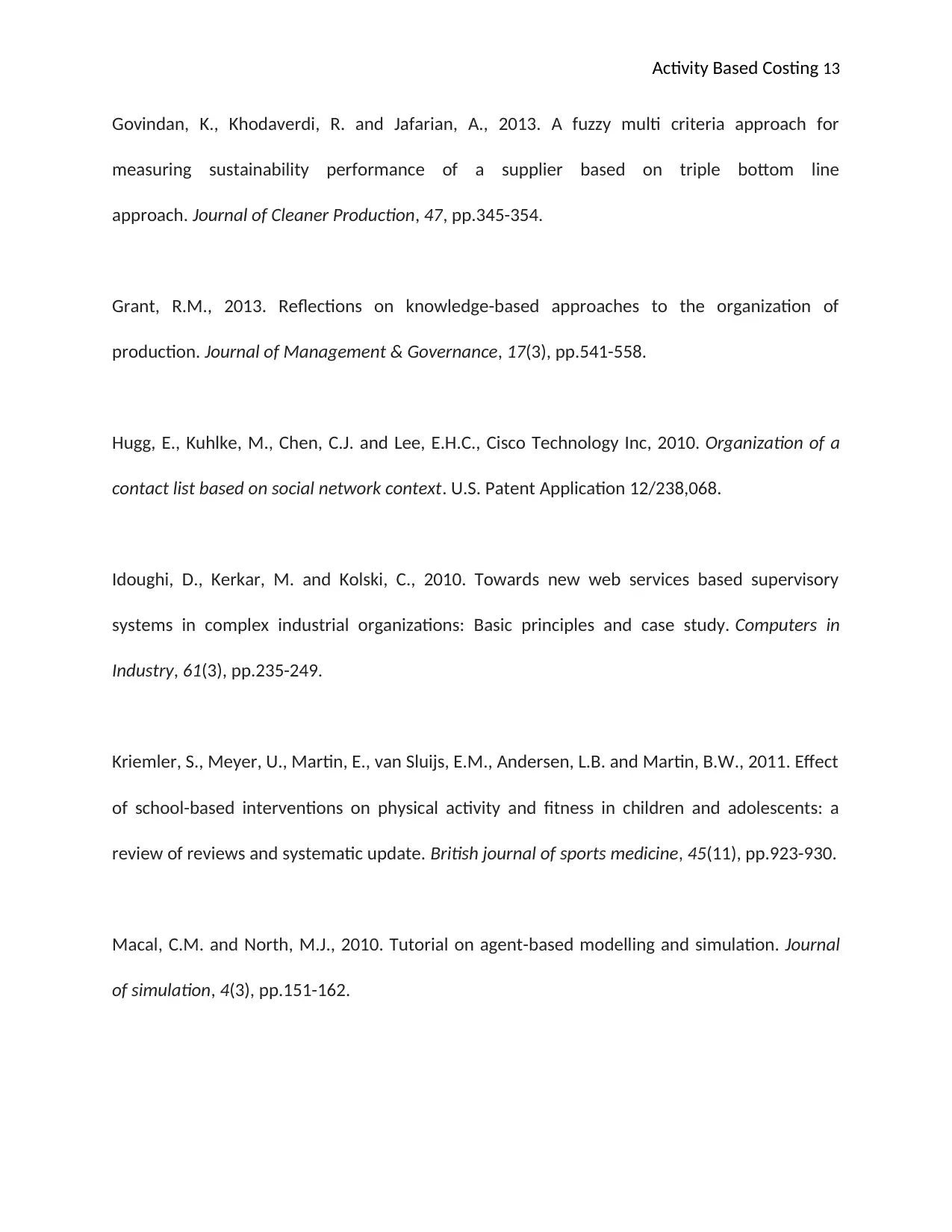
Activity Based Costing 13
Govindan, K., Khodaverdi, R. and Jafarian, A., 2013. A fuzzy multi criteria approach for
measuring sustainability performance of a supplier based on triple bottom line
approach. Journal of Cleaner Production, 47, pp.345-354.
Grant, R.M., 2013. Reflections on knowledge-based approaches to the organization of
production. Journal of Management & Governance, 17(3), pp.541-558.
Hugg, E., Kuhlke, M., Chen, C.J. and Lee, E.H.C., Cisco Technology Inc, 2010. Organization of a
contact list based on social network context. U.S. Patent Application 12/238,068.
Idoughi, D., Kerkar, M. and Kolski, C., 2010. Towards new web services based supervisory
systems in complex industrial organizations: Basic principles and case study. Computers in
Industry, 61(3), pp.235-249.
Kriemler, S., Meyer, U., Martin, E., van Sluijs, E.M., Andersen, L.B. and Martin, B.W., 2011. Effect
of school-based interventions on physical activity and fitness in children and adolescents: a
review of reviews and systematic update. British journal of sports medicine, 45(11), pp.923-930.
Macal, C.M. and North, M.J., 2010. Tutorial on agent-based modelling and simulation. Journal
of simulation, 4(3), pp.151-162.
Govindan, K., Khodaverdi, R. and Jafarian, A., 2013. A fuzzy multi criteria approach for
measuring sustainability performance of a supplier based on triple bottom line
approach. Journal of Cleaner Production, 47, pp.345-354.
Grant, R.M., 2013. Reflections on knowledge-based approaches to the organization of
production. Journal of Management & Governance, 17(3), pp.541-558.
Hugg, E., Kuhlke, M., Chen, C.J. and Lee, E.H.C., Cisco Technology Inc, 2010. Organization of a
contact list based on social network context. U.S. Patent Application 12/238,068.
Idoughi, D., Kerkar, M. and Kolski, C., 2010. Towards new web services based supervisory
systems in complex industrial organizations: Basic principles and case study. Computers in
Industry, 61(3), pp.235-249.
Kriemler, S., Meyer, U., Martin, E., van Sluijs, E.M., Andersen, L.B. and Martin, B.W., 2011. Effect
of school-based interventions on physical activity and fitness in children and adolescents: a
review of reviews and systematic update. British journal of sports medicine, 45(11), pp.923-930.
Macal, C.M. and North, M.J., 2010. Tutorial on agent-based modelling and simulation. Journal
of simulation, 4(3), pp.151-162.
Paraphrase This Document
Need a fresh take? Get an instant paraphrase of this document with our AI Paraphraser
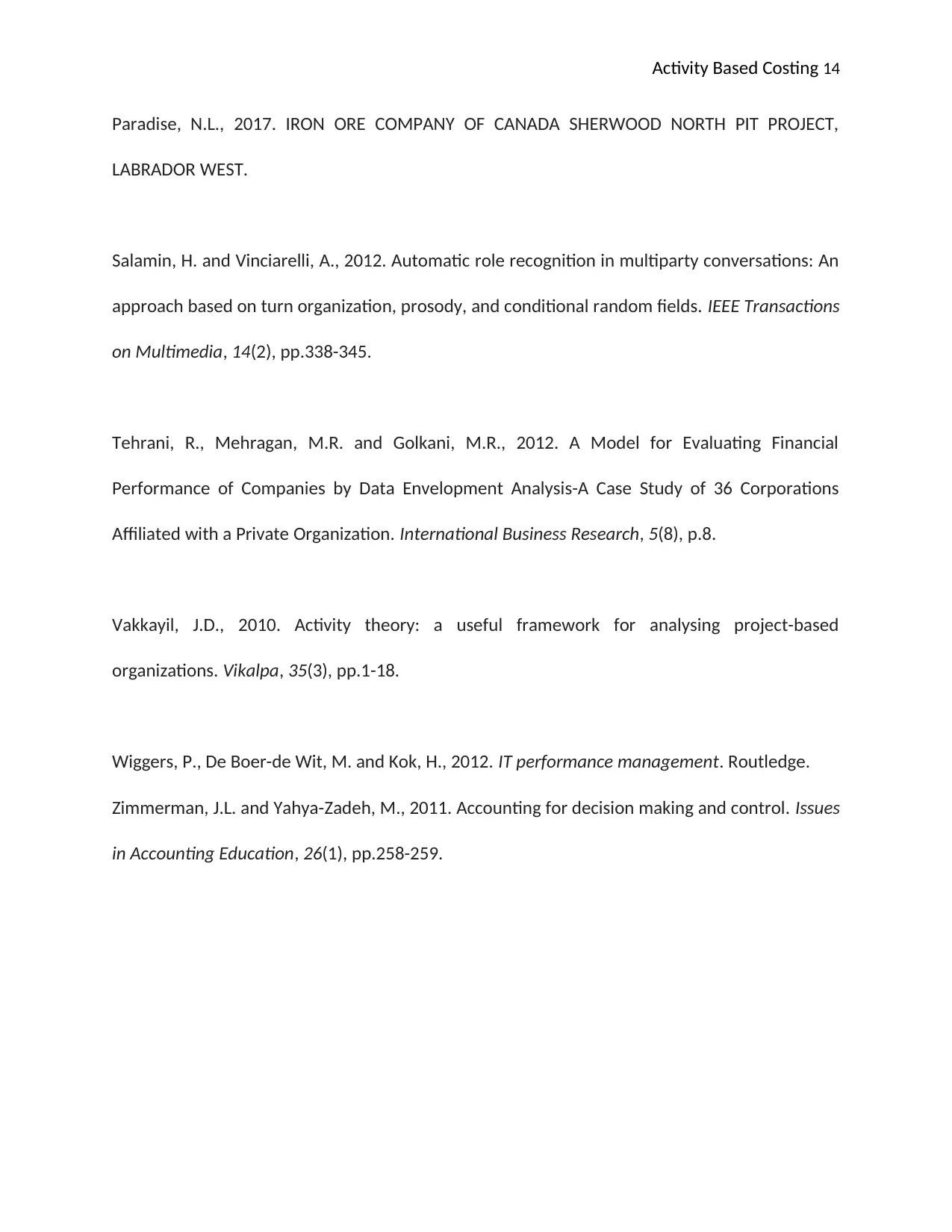
Activity Based Costing 14
Paradise, N.L., 2017. IRON ORE COMPANY OF CANADA SHERWOOD NORTH PIT PROJECT,
LABRADOR WEST.
Salamin, H. and Vinciarelli, A., 2012. Automatic role recognition in multiparty conversations: An
approach based on turn organization, prosody, and conditional random fields. IEEE Transactions
on Multimedia, 14(2), pp.338-345.
Tehrani, R., Mehragan, M.R. and Golkani, M.R., 2012. A Model for Evaluating Financial
Performance of Companies by Data Envelopment Analysis-A Case Study of 36 Corporations
Affiliated with a Private Organization. International Business Research, 5(8), p.8.
Vakkayil, J.D., 2010. Activity theory: a useful framework for analysing project-based
organizations. Vikalpa, 35(3), pp.1-18.
Wiggers, P., De Boer-de Wit, M. and Kok, H., 2012. IT performance management. Routledge.
Zimmerman, J.L. and Yahya-Zadeh, M., 2011. Accounting for decision making and control. Issues
in Accounting Education, 26(1), pp.258-259.
Paradise, N.L., 2017. IRON ORE COMPANY OF CANADA SHERWOOD NORTH PIT PROJECT,
LABRADOR WEST.
Salamin, H. and Vinciarelli, A., 2012. Automatic role recognition in multiparty conversations: An
approach based on turn organization, prosody, and conditional random fields. IEEE Transactions
on Multimedia, 14(2), pp.338-345.
Tehrani, R., Mehragan, M.R. and Golkani, M.R., 2012. A Model for Evaluating Financial
Performance of Companies by Data Envelopment Analysis-A Case Study of 36 Corporations
Affiliated with a Private Organization. International Business Research, 5(8), p.8.
Vakkayil, J.D., 2010. Activity theory: a useful framework for analysing project-based
organizations. Vikalpa, 35(3), pp.1-18.
Wiggers, P., De Boer-de Wit, M. and Kok, H., 2012. IT performance management. Routledge.
Zimmerman, J.L. and Yahya-Zadeh, M., 2011. Accounting for decision making and control. Issues
in Accounting Education, 26(1), pp.258-259.

Activity Based Costing 15
1 out of 15
Related Documents
Your All-in-One AI-Powered Toolkit for Academic Success.
+13062052269
info@desklib.com
Available 24*7 on WhatsApp / Email
![[object Object]](/_next/static/media/star-bottom.7253800d.svg)
Unlock your academic potential
© 2024 | Zucol Services PVT LTD | All rights reserved.





